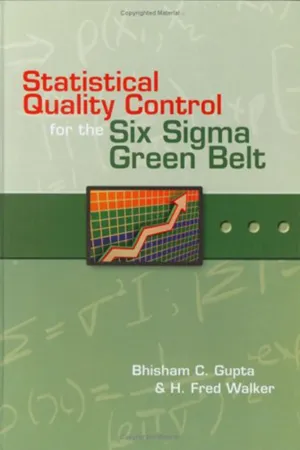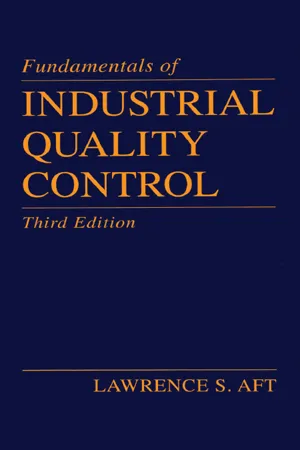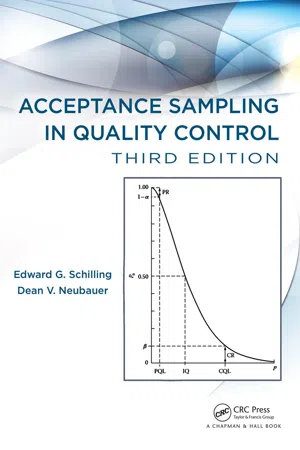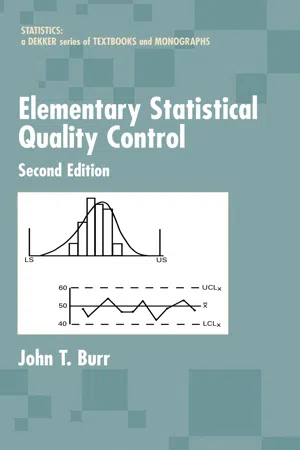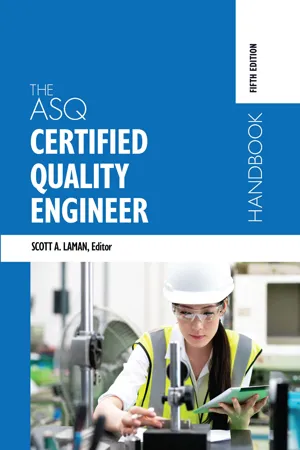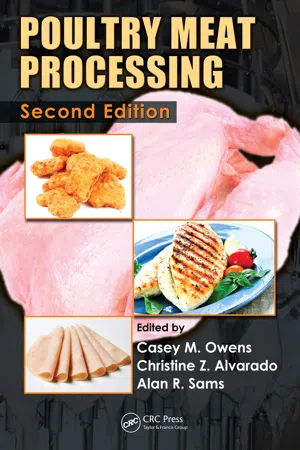Technology & Engineering
Acceptance Sampling
Acceptance sampling is a quality control technique used to inspect a sample of products to determine if the entire batch meets quality standards. It involves randomly selecting a sample from a larger batch and making a decision about whether to accept or reject the entire batch based on the quality of the sample. This method is commonly used in manufacturing and production processes to ensure product quality.
Written by Perlego with AI-assistance
Related key terms
1 of 5
11 Key excerpts on "Acceptance Sampling"
- Bhisham C. Gupta, H. Fred Walker(Authors)
- 2007(Publication Date)
- ASQ Quality Press(Publisher)
173 9.1 The Intent of Acceptance Sampling1 Acceptance Sampling is a method for inspecting a product. Inspection can be done with screening (also called sorting, or 100 percent inspection), in which all units are inspected, or with sampling. Acceptance Sampling is the process of inspecting a portion of the product in a lot for the purpose of mak- ing a decision regarding classification of the entire lot as either conforming or nonconforming to quality specifications. Whether inspection is done with screening or with sampling, the results can be used for different purposes, as follows: 1. To distinguish between good lots and bad lots using Acceptance Sampling plans (as in incoming material inspection and final product inspection). 2. To distinguish between good products and bad products. 3. To determine the status of process control and whether the process is changing. This is usually done in conjunction with control charts. 4. To evaluate process capability. In this case, inspection is used to determine whether the process exhibits excessive variation and whether it is approaching or exceeding the specification limits. 5. To determine process adjustment. Based on inspection results of process output, as depicted by a histogram, for example, the process mean may require adjustment and/or process variation may need to be reduced. A process might require adjustment even though all the units produced to date conform to the quality standards agreed upon with the customer. Originally published in a slightly different form in R. W. Berger, D. W. Benbow, A. K. Elshen- nawy, and H. F. Walker, eds., The Certified Quality Engineer Handbook, 2nd ed. (Milwaukee, WI: ASQ Quality Press, 2007), 190–242. Reprinted with permission. 9 Acceptance Sampling 174 Chapter Nine 6. To rate the accuracy of inspectors or inspection equipment by comparing the inspection results with the corresponding standards.- eBook - ePub
- Lawrence S. Aft(Author)
- 2018(Publication Date)
- CRC Press(Publisher)
10 Acceptance Sampling IntroductionEven before the 1920’s, industry was learning how to do things more scientifically, using such techniques as the Gantt chart, under principles developed by Taylor, Gilbreth, and others in a movement called “scientific management” And in 1922, G.S. Radford published his book, The Control of Quality in Manufacturing. But the Bell System group was organized with what proved to be a new approach to the problem of quality, having as its broad objective the quality of performance of a rapidly growing nationwide communications system. New techniques and procedures were sought for getting the highly needed, highly uniform quality of the many elements of the complete telephone system. At that time, when it was common practice for products and services to strike a balance between schedules and costs, it was proposed to add a third factor — quality …A number of techniques, such as …Acceptance Sampling inspections plans, were essentially statistical in nature. (Dodge, 1969, p. 78 )Thus, Acceptance Sampling has been used in some form since the 1920s. When a manufacturing concern purchases parts, when a restaurant purchases food, or when any other organization purchases raw material for further processing, it hopes to purchase only material meeting specifications. But since no supplier ever provides completely acceptable material all of the time — random variation enters every process — most concerns inspect the product that has been ordered to determine if the material conforms to the agreed upon quality standards.Inspection is the process of comparing actual measurable characteristics with predetermined standard characteristics.There are three basic ways to perform inspections. First, every single part that is received may be inspected. This is referred to as 100 percent inspection. It has several drawbacks. Often the cost is prohibitive, as is the time required to inspect every piece of material received. Also, Samson, Hart, and Rubin have vividly illustrated that because 100 percent inspection often involves long periods of highly repetitive and monotonous work, it is not always 100 percent effective (Samson et al., 1970, p. 72 - eBook - PDF
- Douglas C. Montgomery, Cheryl L. Jennings, Michele E. Pfund(Authors)
- 2015(Publication Date)
- Wiley(Publisher)
A typical application of acceptance-sampling is as follows: A company receives a shipment of product from a supplier. This prod- uct is often a component or raw material used in the company’s manufacturing process. A sample is taken from the lot, and some quality characteristic of the units in the sample is inspected. On the basis of the information in this sample, a decision is made regarding lot disposition. Usually, this decision is either to accept or to reject the lot. Sometimes we refer to this decision as lot sentencing. Accepted lots are put into production; rejected lots may be returned to the supplier or may be subjected to some other lot disposition action. Although it is customary to think of acceptance-sampling as a receiving inspection activity, there are other uses of sampling methods. For example, frequently a manufacturer will sample and inspect its own product at various stages of production. Lots that are accepted are sent forward for further processing, and rejected lots may be reworked or scrapped. Three aspects of sampling are important: 1. It is the purpose of acceptance-sampling to sentence lots, not to estimate the lot quality. Most acceptance-sampling plans are not designed for estimation purposes. 2. Acceptance-sampling plans do not provide any direct form of quality control. Acceptance-sampling simply accepts and rejects lots. Even if all lots are of the same quality, sampling will accept some lots and reject others, the accepted lots being no better than the rejected ones. Process controls are used to control and systematically improve quality, but acceptance- sampling does not. 3. The most effective use of acceptance-sampling is not to “inspect quality into the product,” but rather as an audit tool to ensure that the output of a process conforms to requirements. - eBook - ePub
Textile Engineering
Statistical Techniques, Design of Experiments and Stochastic Modeling
- Anindya Ghosh, Bapi Saha, Prithwiraj Mal(Authors)
- 2021(Publication Date)
- CRC Press(Publisher)
11 Statistical Quality ControlDOI: 10.1201/9781003081234-1111.1 Introduction
Quality control is a method of inspecting the quality of manufactured articles by means of testing. In most situations, 100% inspection, that is inspecting each and every article, is practically impossible and therefore it is most suitable to inspect a random sample of a few articles. Sampling inspection can be carried out at many stages in a manufacturing process. There may be inspection of raw materials, process inspection at various points in the manufacturing operation, inspection of semi-finished products and finally the inspection of finished products. When the sampling inspection is done for the purpose of acceptance or rejection of a batch of raw materials or a batch of products, the statistical technique employed in dealing such situation is termed as Acceptance Sampling. When the sampling inspection is done at the conversion stage for detecting whether the manufacturing process is under control or out of control, the statistical technique employed in dealing such situation is called the control chart. The control charts are widely used for monitoring the manufacturing process. In order to achieve the targeted quality of products, the manufacturing process must be kept under control. If the control chart exhibits the evidence that the process is out of control due to some assignable causes, then it is the job of the quality control engineer to determine the causes and take remedial action.11.2 Acceptance Sampling
A typical application of Acceptance Sampling is discussed in the following few lines. A manufacturer receives a shipment of product from a vendor. A sample is taken from the lot for inspecting some quality characteristics. On the basis of the information in this sample, a decision is made whether the lot will be accepted or rejected. Sometimes the articles are inspected simply on the basis of either defective or non-defective and the sampling scheme dealing such type of inspection is called the Acceptance Sampling for attributes. When the quality characteristics of the articles are measured on a numerical scale, then the adopted sampling scheme is called the Acceptance Sampling for variables. - eBook - PDF
Statistical Quality Control
A Modern Introduction
- Douglas C. Montgomery(Author)
- 2014(Publication Date)
- Wiley(Publisher)
Acceptance Sampling Inspection of raw materials, semifinished products, or finished products is one aspect of quality assurance. When inspection is for the purpose of accep- tance or rejection of a product, based on adherence to a standard, the type of inspection procedure employed is usually called Acceptance Sampling. This section presents two chapters that deal with the design and use of sam- pling plans, schemes, and systems. The primary focus is on lot-by-lot accep- tance sampling. Chapter 15 presents lot-by-lot acceptance-sampling plans for attributes. Included in the chapter is a discussion of MIL STD 105E and its civilian coun- terpart, ANSI/ASQC Z1.4. Variables sampling plans are presented in Chapter 16, including MIL STD 414 and its civilian counterpart, ANSI/ASQC Z1.9, along with a survey of several additional topics in Acceptance Sampling, including chain-sampling plans, sampling plans for continuous production, and skip-lot sampling plans. The underlying philosophy here is that Acceptance Sampling is not a substi- tute for adequate process monitoring and control and use of other statistical methods to drive variability reduction. The successful use of these tech- niques at the early stages of manufacturing, including the supplier or supplier base, can greatly reduce and in some cases eliminate the need for extensive sampling inspection. Acceptance Sampling PART 6 PART 6 This page is intentionally left blank - eBook - PDF
Random Phenomena
Fundamentals of Probability and Statistics for Engineers
- Babatunde A. Ogunnaike(Author)
- 2009(Publication Date)
- CRC Press(Publisher)
If anything, making the product well every time and all the time, became a more challenging endeavor with the advent of mass production. It is only natural, therefore, that ensuring the quality of mass produced goods has since become an integral part of any serious manufacturing enterprise. At first, Acceptance Sampling was introduced by customers to protect themselves from inadvertently receiving products of inferior quality and only discovering these defective items afterwards. Before a manufactured lot is accepted by the consumer, the strategy calls for a sample to be tested first, with the re-sults of the test serving as a rational basis for deciding whether to accept the entire lot or to reject it. Producers later incorporated Acceptance Sampling into their product release protocols to prevent sending out inferior quality products. However, such an “after-the-fact” strategy was soon recognized as inefficient and, in the long run, too expensive. The subsequent evolution of quality assurance through process and quality control (where the objective is to identify causes of poor quality and correct them during production) to the total quality management philosophy of zero defects (which requires, in addi-tion, the design of processes and process operating parameters to minimize the effect of uncontrollable factors on product quality) was rapid and inevitable. A complete and thorough treatment of quality assurance and control re-quires more space than a single chapter can afford. As such, our objective in this chapter is more modestly set at providing an overview of the key concepts underlying three primary modes of quality assurance. We discuss first Acceptance Sampling, from the consumer’s as well as the producer’s per-spectives; we then discuss in some detail, process and quality control, where the focus is on the manufacturing process itself. - eBook - ePub
- Edward G. Schilling, Dean V. Neubauer(Authors)
- 2017(Publication Date)
- Chapman and Hall/CRC(Publisher)
19Administration of Acceptance Sampling
Effective Acceptance Sampling involves more than the selection and application of specific rules for lot inspection. As an integral part of the quality system, the Acceptance Sampling plan, applied on a lot-by-lot basis, becomes an element in the overall approach to maximizing quality at minimum cost. Acceptance Sampling plans are, after all, action rules and as such must be adapted in a rational way to the current results and the nature and history of the inspection performed. This is what we have called acceptance control, involving a continuing strategy of selection, application, and modification of Acceptance Sampling procedures to a changing inspection environment.While Acceptance Sampling is sometimes regarded as a passive procedure for adjudication of quality, the active role of inspection was recognized early by Dodge. In accepting the Shewhart Medal from the American Society for Quality Control, Dodge (1950, p. 6) pointed out thatAs such, inspection should involveUsing the inspection results as a basis for action on the product at hand for deciding whether to accept or reject individual articles or lots of the product as they come along is, of course, an immediate chore that we always have with us. However, the inspection results also provide a basis for action on the production process for the benefit of the future product, for deciding whether the process should be left alone or action taken to find and eliminate disturbing causes.- Good data
- Quick information
- Incentives for the producer to provide quality at satisfactory levels
- Quantity of inspection in keeping with quality history
A product with a history of consistently good quality requires less inspection than the one with no history or a history of erratic quality. Accordingly, it is good practice to include in inspection procedures provisions for reducing or increasing the amount of inspection, depending on the character and quantity of evidence at hand regarding the level of quality and the degree of control shown. - eBook - PDF
- John T. Burr(Author)
- 2004(Publication Date)
- CRC Press(Publisher)
9 Acceptance Sampling for Attributes For the moment, let us consider the general problem of decid-ing whether to accept a lot from a vendor, subcontractor, or another department or line. This can of course be done by inspecting or testing every item or piece in the lot. But this can be expensive and time consuming. Moreover, it is quite often unnecessary, as we shall see. Sound decisions can often be made from a sample from the lot. The criteria of quality of pieces and of the lot may be on the basis of measurements or the presence or absence of defects, that is, by attributes. It is the latter class of criteria, which we will take up in this chapter and the next. Sampling acceptance by measurements is discussed in Chapter 10. 9.1. WHY USE A SAMPLE FOR A DECISION ON A LOT? There are several reasons why we may wish to use a sample from a lot or process for decision making as a basis for action, rather than inspecting or testing all pieces: 241 9052-9 Burr Ch09 R2 072604 1. To save money and time : Unless the characteristic in question is extremely critical, sampling accep-tance plans are often satisfactory for a decision. They can be set up so at to reliably distinguish between ‘‘good’’ lots and ‘‘rejectable’’ lots. The degree of relia-bility of such discrimination can be specified in advance and to any desired degree of confidence. 2. Very often the inspection of a sample of pieces can be and is done much more carefully than 100% inspec-tion of the entire lot. This is because of fatigue and psychological factors. It may even be possible to find out the lot quality more accurately from a sample than from inspection of the entire lot! One hundred percent inspection can be notoriously poor. Some mechanical inspection can, of course, be highly accurate. 3. When the test is destructive , 100% testing of pieces is impossible, for then there would be no pieces left to use even if the lot were shown to have been perfect. - eBook - PDF
- Scott A. Laman(Author)
- 2022(Publication Date)
- ASQ Quality Press(Publisher)
This would be the case for critical or complex products, where the cost of making the wrong decision would be too high. Screening is appropriate when the fraction nonconforming is extremely high. In this case, most of the lots would be rejected under Acceptance Sampling and those accepted would be so as a result of statisti- cal variations rather than better quality. Screening is also appropriate when the Chapter 4 Product and Process Control 195 fraction nonconforming is not known and an estimate based on a large sample is needed. Sampling Concepts Apply the concepts of producer and consumer risk, and related terms, including operating characteristic (OC) curves, acceptable quality limit (AQL), and lot tolerance percent defective (LTPD). (Apply) Body of Knowledge IV.C.1 Sampling may be performed according to the type of quality characteristics to be inspected. There are three major categories of sampling plans: sampling plans for attributes, sampling plans for variables, and special sampling plans. It should be noted that Acceptance Sampling is not advised for processes in continuous production and in a state of statistical control. For these processes, Deming (1986) provides decision rules for selecting either 100% inspection or no inspection. There are risks involved in using Acceptance Sampling plans. These risks are producer’s risk and consumer’s risk, and correspond with type I and type II errors, respectively, in hypothesis testing (type I and type II errors are discussed in Chapter 6). Producer’s risk and consumer’s risks are defined as follows: • Producer’s risk (α). The producer’s risk for any given sampling plan is the probability of rejecting a lot that is within the acceptable quality level. This means that the producer faces the possibility (at level of significance α) of having a lot rejected even though the lot has met the requirements stipulated by the acceptance quality limit (AQL). - eBook - PDF
- Casey M. Owens(Author)
- 2010(Publication Date)
- CRC Press(Publisher)
Different tools to perform this function have been developed in the past 60 years in response to these needs in industries other than poultry. The two most common forms adopted for use in poultry processing are Acceptance Sampling programs and Process Control techniques. These are very different techniques and approaches for quality control, but both are based on sound science and statistics, and they work very well when used appropriately. Acceptance Sampling Acceptance Sampling techniques, based on the U.S. Armed Forces Military Standard (Mil Std) 105E inspection program published in 1989, is the predominate form of quality assessment practiced by the poultry-processing industry. Many companies still utilize the older version, Military Standard 105D, published in 1963. To save costs, the Department of Defense canceled Mil Std 105E in 1995, and these standards are currently available in the ANSI document Z 1.4. This program functions as follows: individual samples, the number and frequency of which are predetermined during program setup, are randomly selected and tested for the Essential Comprehensive Pest Control Program Water Potability Testing Certificate Backflow Prevention Device Verification Recall Program Letters of Guarantee Customer/Consumer Complaints Recommended Self-inspection/Audit Program Incoming Goods Inspection Program Waste Removal Program Air Filter Cleaning/Replacement Plan Condensation Prevention/Removal Plan Grounds Maintenance Program Pesticide/Chemical Stroge Requirements Metal Detection/Elimination Procedures Truck-trailer Inspection Plan Product Testing Results File Vendor Certification Audit Reports Emergency Response Plan Figure 16.2 Components, essential and recommended, to be included in the quality manual. Chapter sixteen: Quality assurance and process control 343 appropriate attribute. The samples are counted as pass or fail depending on the specifica-tion for that product and specific attribute. - Myer Kutz(Author)
- 2015(Publication Date)
- Wiley(Publisher)
The objective of Acceptance Sampling is to determine whether a quantity of the output of a process is acceptable according to some criterion of quality. A sample from the lot is inspected, and the lot is accepted or rejected in accordance with the findings of the sample.Acceptance Sampling plans call for the random selection of sample of size n from a lot containing N items. The lot is accepted if the number of defectives found in the sample are ≤ c, the acceptance number. A rejected lot can either be returned to the producer, nonrectifying inspections, or it can be retained and subjected to a 100% screening process, rectifying inspection plan improves the outgoing quality. A second attribute-inspection plan might use two samples before requiring the acceptance or rejection of a lot. A third plan might use multiple samples or a sequential sampling process in evaluating a lot. Under rectifying inspection programs, the average outgoing quality level (AOQ), the average inspection lot (I), and the average outgoing quality limit (AOQL) can be predicted for varying levels of incoming fraction defective p.Assuming that all lots arriving contain the same proportion of defectives p, and that rejected lots will be subjected to 100% inspection, AOQ and I are given below:(24.30)(24.31)The average outgoing quality (AOQ) increases as the proportion defective in the incoming lots increases until it reaches a maximum value and then starts to decrease. This maximum value is referred to as the average outgoing quality limit. The hypergeometric distribution is the appropriate distribution to calculate the probability of acceptance Pa; however, the Poisson distribution is used as an approximation.Nonrectifying inspection program does not significantly improve the quality level of the lots inspected.24.7.1 Double Sampling
Double sampling involves the possibility of putting off the decision on the lot until a second sample has been taken. A lot may be accepted at once if the first sample is good enough or rejected at once if the first sample is bad enough. If the first sample is neither, the decision is based on the evidence of the first and second samples combined.
Index pages curate the most relevant extracts from our library of academic textbooks. They’ve been created using an in-house natural language model (NLM), each adding context and meaning to key research topics.
